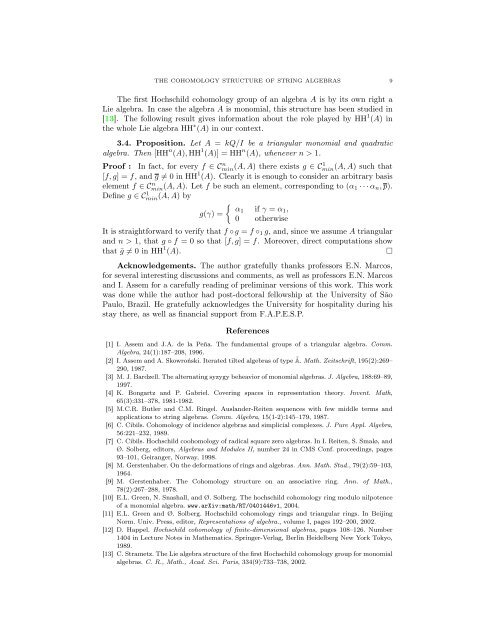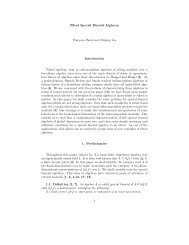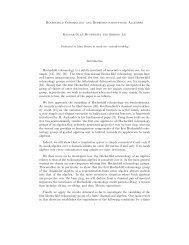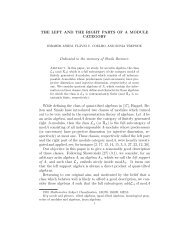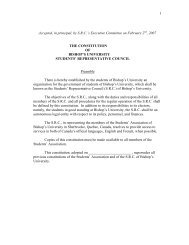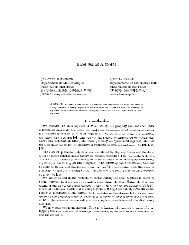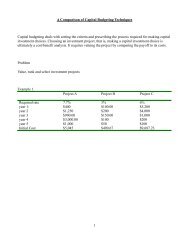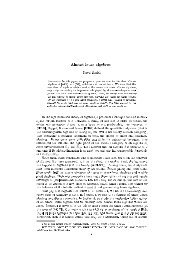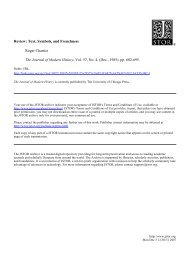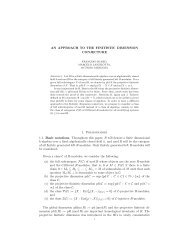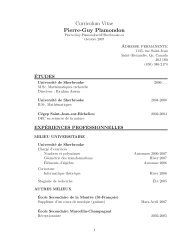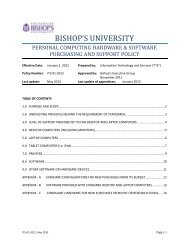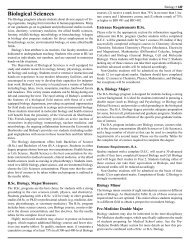The cohomology structure of string algebras
The cohomology structure of string algebras
The cohomology structure of string algebras
You also want an ePaper? Increase the reach of your titles
YUMPU automatically turns print PDFs into web optimized ePapers that Google loves.
THE COHOMOLOGY STRUCTURE OF STRING ALGEBRAS 9<br />
<strong>The</strong> first Hochschild <strong>cohomology</strong> group <strong>of</strong> an algebra A is by its own right a<br />
Lie algebra. In case the algebra A is monomial, this <strong>structure</strong> has been studied in<br />
[13]. <strong>The</strong> following result gives information about the role played by HH 1 (A) in<br />
the whole Lie algebra HH ∗ (A) in our context.<br />
3.4. Proposition. Let A = kQ/I be a triangular monomial and quadratic<br />
algebra. <strong>The</strong>n [HH n (A), HH 1 (A)] = HH n (A), whenever n > 1.<br />
Pro<strong>of</strong> : In fact, for every f ∈ Cmin n (A, A) there exists g ∈ C1 min (A, A) such that<br />
[f, g] = f, and g ≠ 0 in HH 1 (A). Clearly it is enough to consider an arbitrary basis<br />
element f ∈ Cmin n (A, A). Let f be such an element, corresponding to (α 1 · · · α n , p).<br />
Define g ∈ Cmin 1 (A, A) by {<br />
α1 if γ = α<br />
g(γ) =<br />
1 ,<br />
0 otherwise<br />
It is straightforward to verify that f ◦ g = f ◦ 1 g, and, since we assume A triangular<br />
and n > 1, that g ◦ f = 0 so that [f, g] = f. Moreover, direct computations show<br />
that ḡ ≠ 0 in HH 1 (A).<br />
□<br />
Acknowledgements. <strong>The</strong> author gratefully thanks pr<strong>of</strong>essors E.N. Marcos,<br />
for several interesting discussions and comments, as well as pr<strong>of</strong>essors E.N. Marcos<br />
and I. Assem for a carefully reading <strong>of</strong> preliminar versions <strong>of</strong> this work. This work<br />
was done while the author had post-doctoral fellowship at the University <strong>of</strong> São<br />
Paulo, Brazil. He gratefully acknowledges the University for hospitality during his<br />
stay there, as well as financial support from F.A.P.E.S.P.<br />
References<br />
[1] I. Assem and J.A. de la Peña. <strong>The</strong> fundamental groups <strong>of</strong> a triangular algebra. Comm.<br />
Algebra, 24(1):187–208, 1996.<br />
[2] I. Assem and A. Skowroński. Iterated tilted <strong>algebras</strong> <strong>of</strong> type Ã. Math. Zeitschrift, 195(2):269–<br />
290, 1987.<br />
[3] M. J. Bardzell. <strong>The</strong> alternating syzygy beheavior <strong>of</strong> monomial <strong>algebras</strong>. J. Algebra, 188:69–89,<br />
1997.<br />
[4] K. Bongartz and P. Gabriel. Covering spaces in representation theory. Invent. Math,<br />
65(3):331–378, 1981-1982.<br />
[5] M.C.R. Butler and C.M. Ringel. Auslander-Reiten sequences with few middle terms and<br />
applications to <strong>string</strong> <strong>algebras</strong>. Comm. Algebra, 15(1-2):145–179, 1987.<br />
[6] C. Cibils. Cohomology <strong>of</strong> incidence <strong>algebras</strong> and simplicial complexes. J. Pure Appl. Algebra,<br />
56:221–232, 1989.<br />
[7] C. Cibils. Hochschild coohomology <strong>of</strong> radical square zero <strong>algebras</strong>. In I. Reiten, S. Smalø, and<br />
Ø. Solberg, editors, Algebras and Modules II, number 24 in CMS Conf. proceedings, pages<br />
93–101, Geiranger, Norway, 1998.<br />
[8] M. Gerstenhaber. On the deformations <strong>of</strong> rings and <strong>algebras</strong>. Ann. Math. Stud., 79(2):59–103,<br />
1964.<br />
[9] M. Gerstenhaber. <strong>The</strong> Cohomology <strong>structure</strong> on an associative ring. Ann. <strong>of</strong> Math.,<br />
78(2):267–288, 1978.<br />
[10] E.L. Green, N. Snashall, and Ø. Solberg. <strong>The</strong> hochschild <strong>cohomology</strong> ring modulo nilpotence<br />
<strong>of</strong> a monomial algebra. www.arXiv:math/RT/0401446v1, 2004.<br />
[11] E.L. Green and Ø. Solberg. Hochschild <strong>cohomology</strong> rings and triangular rings. In Beijing<br />
Norm. Univ. Press, editor, Representations <strong>of</strong> algebra., volume I, pages 192–200, 2002.<br />
[12] D. Happel. Hochschild <strong>cohomology</strong> <strong>of</strong> finite-dimensional <strong>algebras</strong>, pages 108–126. Number<br />
1404 in Lecture Notes in Mathematics. Springer-Verlag, Berlin Heidelberg New York Tokyo,<br />
1989.<br />
[13] C. Strametz. <strong>The</strong> Lie algebra <strong>structure</strong> <strong>of</strong> the first Hochschild <strong>cohomology</strong> group for monomial<br />
<strong>algebras</strong>. C. R., Math., Acad. Sci. Paris, 334(9):733–738, 2002.


